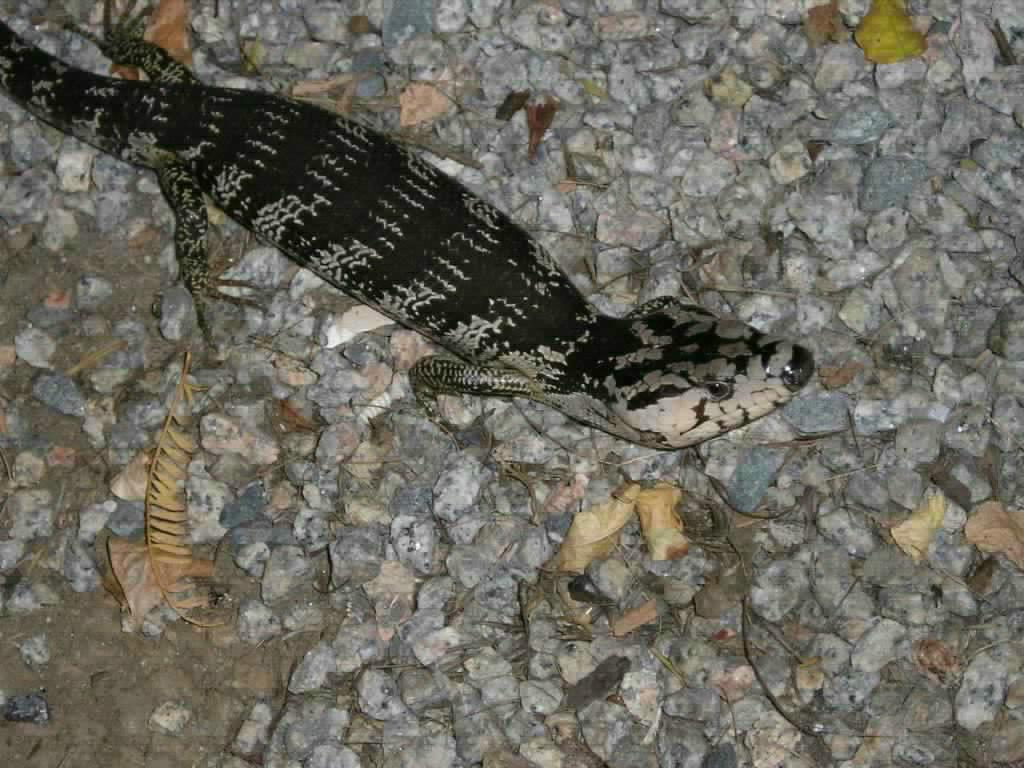

The genus Hemisphaeridon is a monotypic genus from Australia whose species was formerly considered a member of the Tiliqua. This lizard is much better known by its common name, the Pink-Tongue Skink. Although similar in appearance to the Blue-Tongues, its behaviour and habitat are somewhat different. It is more arboreal, and the long tail (up to 1½ times the snout-vent length) is prehensile. Unlike the Blue-Tongues, Pink-Tongues dart their tongues frequently in and out.
Behaviourally this is a nocturnal or crepuscular species.
The animal below was photographed in the spring. It was living in the woodpile of Maleny Lodge in Maleny, Queensland, whose owners sent me the following note:
"He has a lot of attitude! is very aggressive - will not back off or run away and strikes; he has a pink forked ..... He/She is about a foot long and when you just see the head it looks like a snake. He has very short legs and sometimes just rests on his abdomen looking like a short, chubby snake."
 |
 |
Pink-Tongues have been kept successfully in captivity, but the most important thing to remember is that most seem to prefer snails and slugs as their diet. While this might seem easy to provide for those people whose gardens are overrun with these gastropods (especially in Britain), it should be stressed that any pesticide lingering within a wild-caught snail could be highly detrimental to any animal, not least a lizard, eating it, so it is important to make sure as much as one can that pesticides have not been used in the area where the snails or slugs have been collected. Other alternatives to collecting gastropods from the garden include the purchase of aquatic snails from aquarium shops or the setting up of a few African land snails or similar to breed a supply. Rogner recommends the snail species Cepaea nemoralis and Cepaea hortensis, which can be frozen and kept in a fridge.
Apart from gastropods, Pink-Tongues will eat insects such as crickets, sweet fruits and occasionally vegetable matter. Dog food will not be refused, although this should probably be offered only very sparingly. For other details on captive husbandry and breeding, see Rogner or Walls.
Acknowledgements: I would like to thank Hilary and Ian Enloe of Maleny Lodge, Maleny, Queensland, Australia, for their correspondence (including the above photographs) and generosity. Please do pay their site a visit.
| H. gerrardi, Pink-Tongue Skink |
Reptiles and Amphibians of Australia, Harold Cogger, 6th edition, which provided the anatomical information on this page.
Blue-Tongued Skinks: Keeping and Breeding Them in Captivity, Jerry G Walls, TFH 1996. Walls writes well on most herpetological and invertebrate subjects, and this brief book is no exception, covering the taxonomy and requirements not only of the Tiliqua species but also of Cyclodomorphus (Oak Skinks), Hemisphaeriodon (Pink-Tongued Skink) and Trachydosaurus (Pine Cone Skink).
Echsen [Lizards] Vol 2, Rogner, Ullmer Verlag, 1992. Usually a very good source of information. The section on the Pink-Tongue Skink is listed as Tiliqua gerrardi.
Mark Bond's Pink-Tongue Skink Information Centre is based largely on Mark's own experiences and also has other interesting animals featured, such as Fire Skinks and Sugar Gliders.
The Forked Tongue, the Monthly Newsletter of the Greater Cincinnati Herpetological Society, has an article by Mark Bond on page 2 of their October 2002 edition (Acrobat PDF format).
Danish-language page on H. gerrardi.
Back to Skinks | Lizards | Reptiles | Amphibians | Back to Herpetology | Back to Home Page